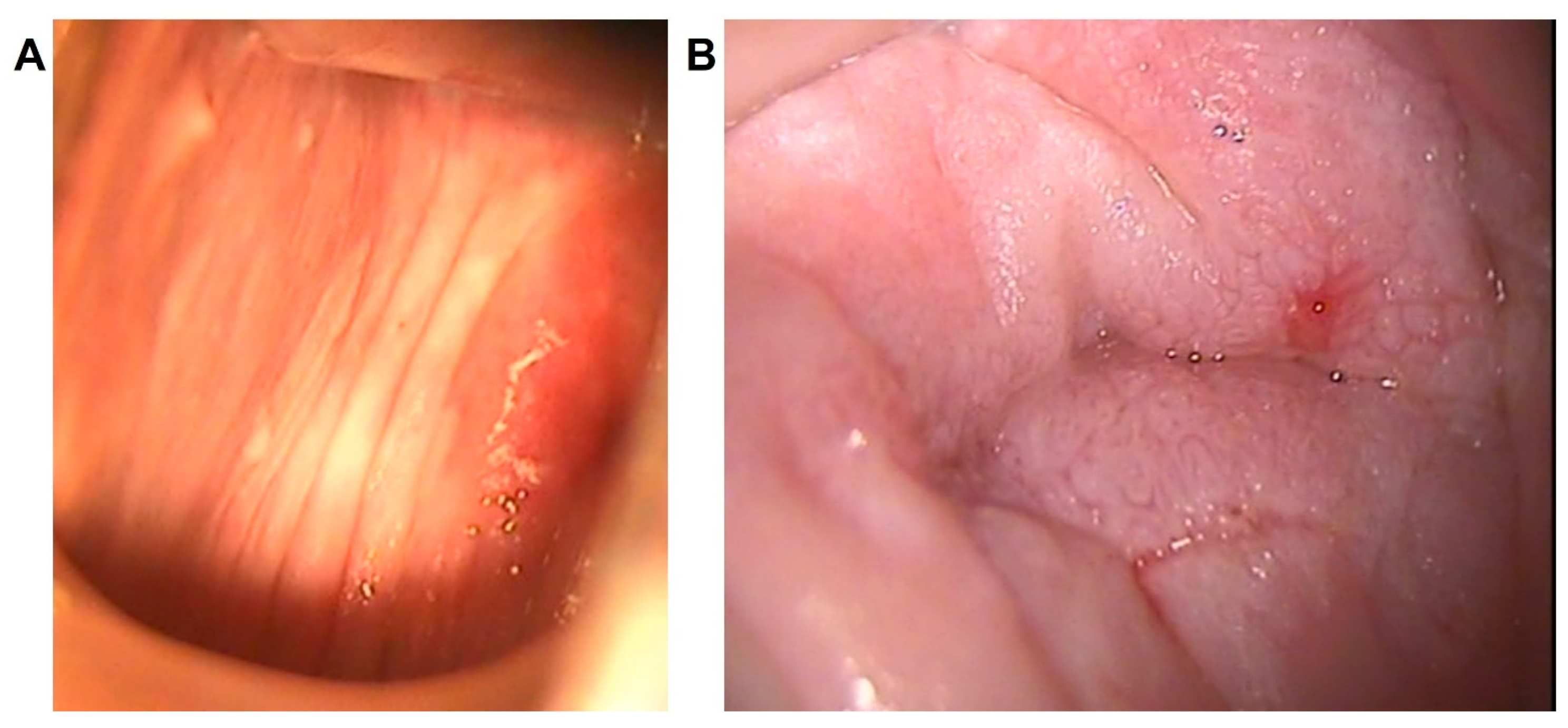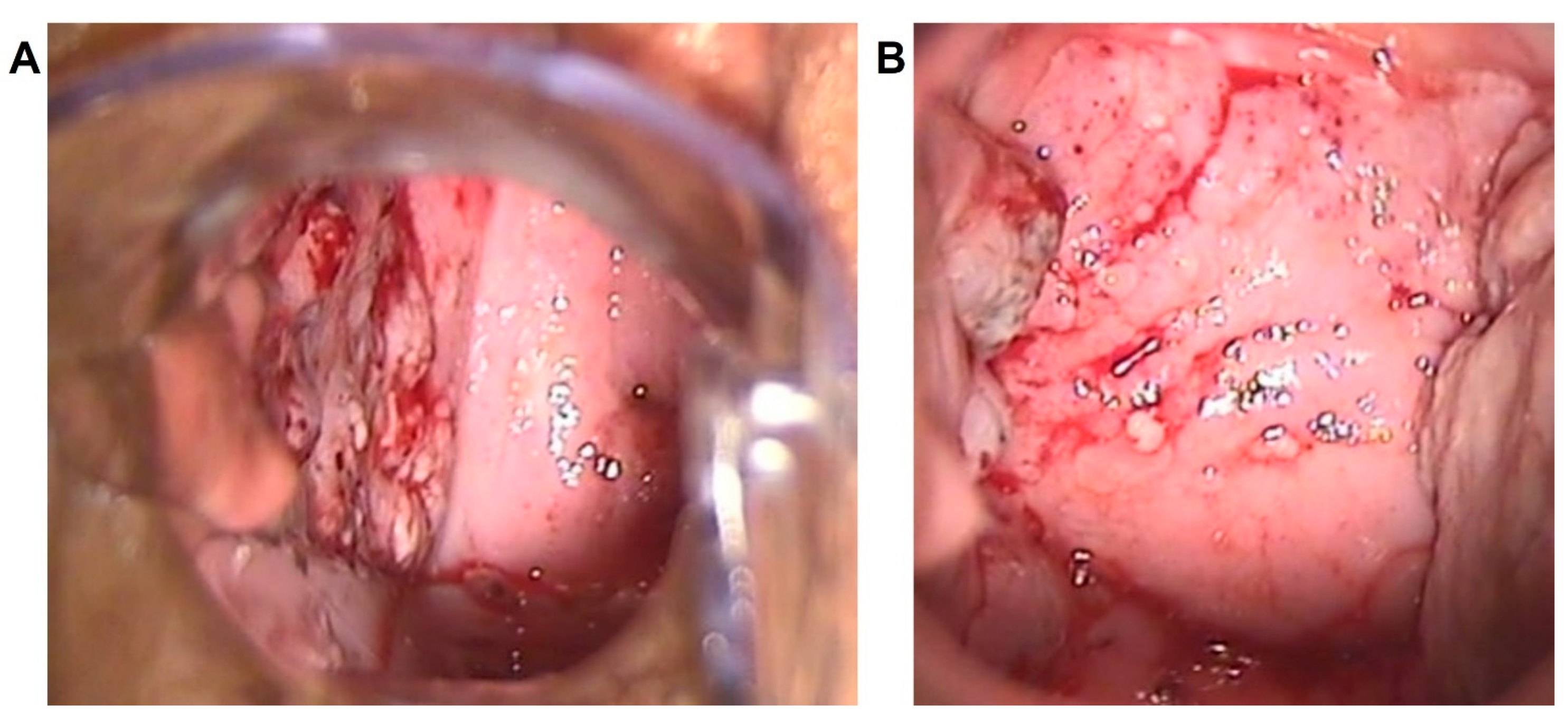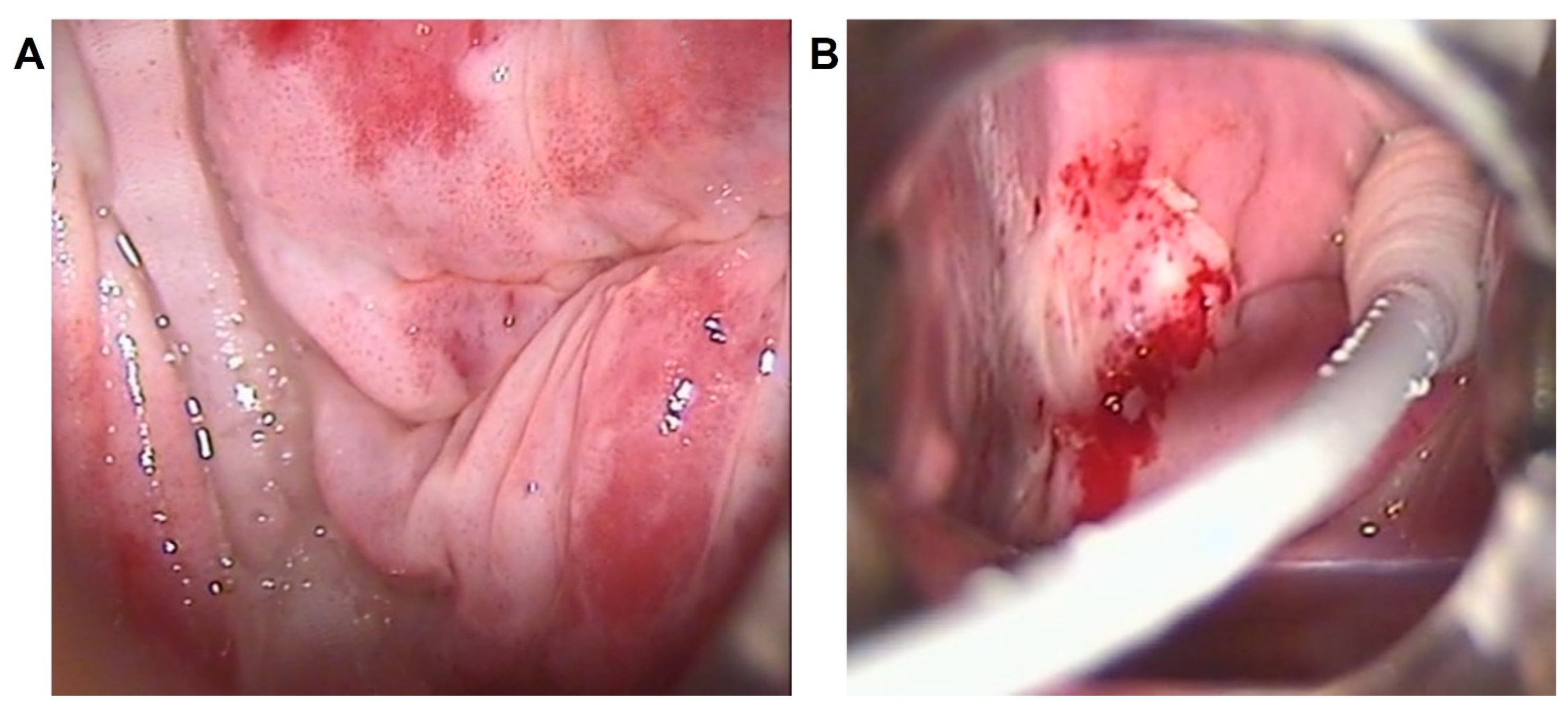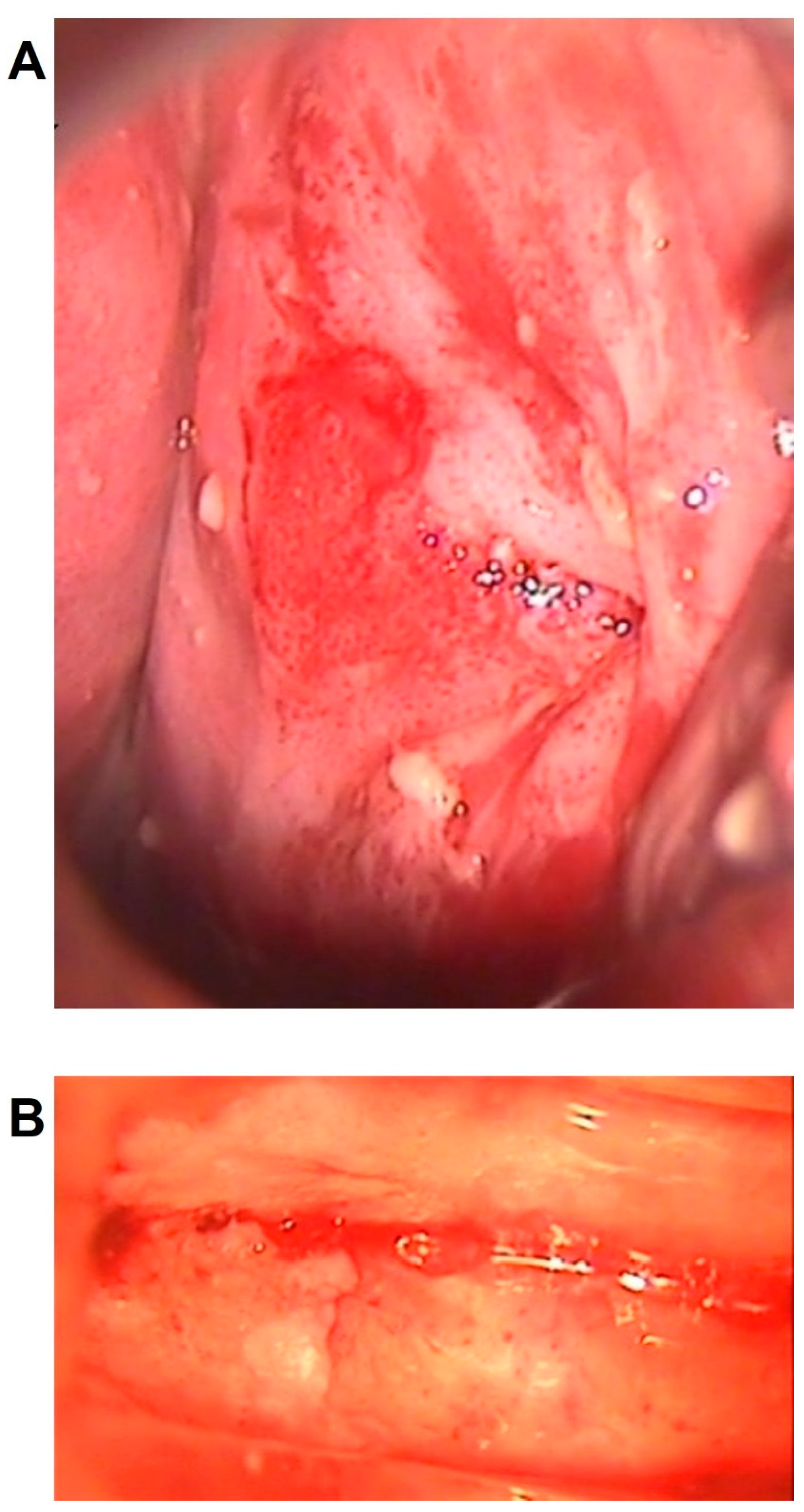Which Risk Factors and Colposcopic Patterns Are Predictive for High-Grade VAIN? A Retrospective Analysis
Abstract
1. Introduction
2. Materials and Methods
Statistical Analysis
3. Results
4. Discussion
5. Conclusions
Supplementary Materials
Author Contributions
Funding
Institutional Review Board Statement
Informed Consent Statement
Data Availability Statement
Acknowledgments
Conflicts of Interest
References
- Sillman, F.H.; Fruchter, R.G.; Chen, Y.S.; Camilien, L.; Sedlis, A.; McTigue, E. Vaginal intraepithelial neoplasia: Risk factors for per-sistence, recurrence, and invasion and its management. Am. J. Obstet. Gynecol. 1997, 176, 93–99. [Google Scholar] [CrossRef] [PubMed]
- Dodge, J.A.; Eltabbakh, G.H.; Mount, S.L.; Walker, R.; Morgan, A. Clinical Features and Risk of Recurrence among Patients with Vaginal Intraepithelial Neoplasia. Gynecol. Oncol. 2001, 83, 363–369. [Google Scholar] [CrossRef] [PubMed]
- Gurumurthy, M.; Cruickshank, M.E. Management of Vaginal Intraepithelial Neoplasia. J. Low. Genit. Tract Dis. 2012, 16, 306–312. [Google Scholar] [CrossRef] [PubMed]
- Hodeib, M.; Cohen, J.G.; Mehta, S.; Rimel, B.; Walsh, C.S.; Li, A.J.; Karlan, B.Y.; Cass, I. Recurrence and risk of progression to lower genital tract malignancy in women with high grade VAIN. Gynecol. Oncol. 2016, 141, 507–510. [Google Scholar] [CrossRef]
- Cong, Q.; Song, Y.; Wang, Q.; Zhang, H.; Gao, S.; Sui, L. A retrospective study of cytology, high-risk HPV and colposcopy results of vaginal intraepithelial neoplasia patients. Biomed. Res. Int. 2018, 8, 5894801. [Google Scholar] [CrossRef]
- Sherman, J.F.; Mount, S.L.; Evans, M.F.; Skelly, J.; Simmons-Arnold, L.; Eltabbakh, G.H. Smoking increases the risk of high-grade vaginal intraepithelial neoplasia in women with oncogenic human papillomavirus. Gynecol. Oncol. 2008, 110, 396–401. [Google Scholar] [CrossRef]
- Schockaert, S.; Poppe, W.; Arbyn, M.; Verguts, T.; Verguts, J. Incidence of vaginal intraepithelial neoplasia after hysterectomy for cervical intraepithelial neoplasia: A retrospective study. Am. J. Obstet. Gynecol. 2008, 199, 113.e1–113.e5. [Google Scholar] [CrossRef]
- Liao, J.B.; Jean, S.; Wilkinson-Ryan, I.; Ford, A.E.; Tanyi, J.L.; Hagemann, A.R.; Lin, L.L.; McGrath, C.M.; Rubin, S.C. Vaginal intraepithelial neoplasia (VAIN) after radiation therapy for gynecologic malignancies: A clinically recalcitrant entity. Gynecol. Oncol. 2011, 120, 108–112. [Google Scholar] [CrossRef]
- Zhou, F.-Y.; Zhou, Q.; Zhu, Z.-Y.; Hua, K.-Q.; Chen, L.-M.; Ding, J.-X. Types and viral load of human papillomavirus, and vaginal microbiota in vaginal intraepithelial neoplasia: A cross-sectional study. Ann. Transl. Med. 2020, 8, 1408. [Google Scholar] [CrossRef]
- Kurman, R.J. WHO Classification of Tumours of Female Reproductive Organs; International Agency for Research on Cancer: Lyon, France, 2014. [Google Scholar]
- Darragh, T.M.; Colgan, T.J.; Thomas Cox, J.; Heller, D.S.; Henry, M.R.; Luff, R.D.; McCalmont, T.; Nayar, R.; Palefsky, J.M.; Stoler, M.H.; et al. The Lower Anogenital Squamous Terminology Standardization project for HPV-associated lesions: Background and consensus recommendations from the College of American Pathologists and the American Society for Colposcopy and Cervical Pathology. Int. J. Gynecol. Pathol. 2013, 32, 76–115. [Google Scholar] [CrossRef]
- Reich, O.; Regauer, S.; Marth, C.; Schmidt, D.; Horn, L.-C.; Dannecker, C.; Menton, M.; Beckmann, M. Precancerous Lesions of the Cervix, Vulva and Vagina According to the 2014 WHO Classification of Tumors of the Female Genital Tract. Geburtshilfe Und Frauenheilkd. 2015, 75, 1018–1020. [Google Scholar] [CrossRef] [PubMed]
- Sopracordevole, F.; Barbero, M.; Clemente, N.; Fallani, M.G.; Cattani, P.; Agarossi, A.; De Piero, G.; Parin, A.; Frega, A.; Boselli, F.; et al. High-grade vaginal intraepithelial neoplasia and risk of progression to vaginal cancer: A multicentre study of the Italian Society of Colposcopy and Cervico-Vaginal Pathology (SICPCV). Eur. Rev. Med. Pharmacol. Sci. 2016, 20, 818–824. [Google Scholar] [PubMed]
- Sopracordevole, F.; De Piero, G.; Clemente, N.; Buttignol, M.; Mancioli, F.; Di Giuseppe, J.; Canzonieri, V.; Giorda, G.; Ciavattini, A. Vaginal intraepithelial neoplasia: Histopathological upgrading of lesions and evidence of occult vaginal cancer. J. Low. Genit. Tract. Dis. 2016, 20, 70–74. [Google Scholar] [CrossRef] [PubMed]
- Gunderson, C.C.; Nugent, E.K.; Elfrink, S.H.; Gold, M.A.; Moore, K.N. A contemporary analysis of epidemiology and management of vaginal intraepithelial neoplasia. Am. J. Obstet. Gynecol. 2013, 208, 410.e1–410.e6. [Google Scholar] [CrossRef]
- Gillet, E.; Meys, J.F.; Verstraelen, H.; Bosire, C.; De Sutter, P.; Temmerman, M.; Broeck, D.V. Bacterial vaginosis is associated with uterine cervical human papillomavirus infection: A meta-analysis. BMC Infect. Dis. 2011, 11, 10. [Google Scholar] [CrossRef]
- Boonlikit, S.; Noinual, N. Vaginal intraepithelial neoplasia: A retrospective analysis of clinical features and colpohistology. J. Obstet. Gynaecol. Res. 2010, 36, 94–100. [Google Scholar] [CrossRef]
- Indraccolo, U.; Baldoni, A. A Simplified Classification for Describing Colposcopic Vaginal Patterns. J. Low. Genit. Tract Dis. 2012, 16, 75–79. [Google Scholar] [CrossRef]
- Sopracordevole, F.; Barbero, M.; Clemente, N.; Fallani, M.G.; Cattani, P.; Agarossi, A.; De Piero, G.; Parin, A.; Frega, A.; Boselli, F.; et al. Colposcopic patterns of vaginal intraepithelial neoplasia: A study from the Italian Society of Colposcopy and Cervico-Vaginal Pathology. Eur. J. Cancer Prev. 2018, 27, 152–157. [Google Scholar] [CrossRef]
- Sopracordevole, F.; Clemente, N.; Barbero, M.; Agarossi, A.; Cattani, P.; Garutti, P.; Fallani, M.G.; Pieralli, A.; Boselli, F.; Frega, A.; et al. Colpo-scopic patterns of vaginal intraepithelial neoplasia: A focus on low-grade lesions. Eur. Rev. Med. Pharmacol. Sci. 2017, 21, 2823–2828. [Google Scholar]
- Bornstein, J.; Bentley, J.; Bösze, P.; Girardi, F.; Haefner, H.; Menton, M.; Perrotta, M.; Prendiville, W.; Russell, P.; Sideri, M.; et al. 2011 Colposcopic Terminology of the International Federation for Cervical Pathology and Colposcopy. Obstet. Gynecol. 2012, 120, 166–172. [Google Scholar] [CrossRef]
- Zhou, Q.; Zhang, F.; Sui, L.; Zhang, H.; Lin, L.; Li, Y. Application of 2011 International Federation for Cervical Pathology and Colposcopy Terminology on the Detection of Vaginal Intraepithelial Neoplasia. Cancer Manag. Res. 2020, 12, 5987–5995. [Google Scholar] [CrossRef] [PubMed]
- Daling, J.R.; Madeleine, M.M.; Schwartz, S.M.; Shera, K.A.; Carter, J.J.; McKnight, B.; Porter, P.L.; Galloway, D.A.; McDougall, J.K.; Tamimi, H. A population-based study of squamous cell vaginal cancer: HPV and cofactors. Gynecol. Oncol. 2002, 84, 263–270. [Google Scholar] [CrossRef] [PubMed]
- Tolstrup, J.; Munk, C.; Thomsen, B.L.; Svare, E.; Brule, A.J.V.D.; Grønbæk, M.K.; Meijer, C.; Kjær, S.K. The role of smoking and alcohol intake in the development of high-grade squamous intraepithelial lesions among high-risk HPV-positive women. Acta Obstet. Gynecol. Scand. 2006, 85, 1114–1119. [Google Scholar] [CrossRef] [PubMed]
- Madsen, B.S.; Jensen, H.L.; Brule, A.J.V.D.; Wohlfahrt, J.; Frisch, M. Risk factors for invasive squamous cell carcinoma of the vulva and vagina—Population-based case–control study in Denmark. Int. J. Cancer 2008, 122, 2827–2834. [Google Scholar] [CrossRef] [PubMed]
- Li, H.; Guo, Y.-L.; Zhang, J.-X.; Qiao, J.; Geng, L. Risk factors for the development of vaginal intraepithelial neoplasia. Chin. Med. J. 2012, 125, 1219–1223. [Google Scholar]
- Cao, D.; Wu, D.; Xu, Y. Vaginal intraepithelial neoplasia in patients after total hysterectomy. Curr. Probl. Cancer 2020, 45, 100687. [Google Scholar] [CrossRef]
- Ao, M.; Zheng, D.; Wang, J.; Gu, X.; Xi, M. Risk factors analysis of persistence, progression and recurrence in vaginal intraepithelial neoplasia. Gynecol. Oncol. 2021, 162, 584–589. [Google Scholar] [CrossRef]
- Bradbury, M.; Xercavins, N.; García-Jiménez, A.; Pérez-Benavente, A.; Franco-Camps, S.; Cabrera, S.; Sánchez-Iglesias, J.L.; De La Torre, J.; Díaz-Feijoo, B.; Gil-Moreno, A.; et al. Vaginal Intraepithelial Neoplasia: Clinical Presentation, Management, and Outcomes in Relation to HIV Infection Status. J. Low. Genit. Tract Dis. 2019, 23, 7–12. [Google Scholar] [CrossRef]
- Zhang, L.; Wang, Q.; Zhang, H.; Xie, Y.; Sui, L.; Cong, Q. Screening History in Vaginal Precancer and Cancer: A Retrospective Study of 2131 Cases in China. Cancer Manag. Res. 2021, 13, 8855–8863. [Google Scholar] [CrossRef]
- Insinga, R.P.; Liaw, K.-L.; Johnson, L.G.; Madeleine, M.M. A systematic review of the prevalence and attribution of human papil-lomavirus types among cervical, vaginal, and vulvar precancers and cancers in the United States. Cancer. Epidemiol. Bi-omarkers. Prev. 2008, 17, 1611–1622. [Google Scholar] [CrossRef]
- Zhang, S.; Saito, M.; Okayama, K.; Okodo, M.; Kurose, N.; Sakamoto, J.; Sasagawa, T. HPV Genotyping by Molecular Mapping of Tissue Samples in Vaginal Intraepithelial Neoplasia (VaIN) and Vaginal Squamous Cell Carcinoma (VaSCC). Cancers 2021, 13, 3260. [Google Scholar] [CrossRef] [PubMed]
- Jentschke, M.; Hoffmeister, V.; Soergel, P.; Hillemanns, P. Clinical presentation, treatment and outcome of vaginal intraepithelial neoplasia. Arch. Gynecol. Obstet. 2015, 293, 415–419. [Google Scholar] [CrossRef] [PubMed]
- Lamos, C.; Mihaljevic, C.; Aulmann, S.; Bruckner, T.; Domschke, C.; Wallwiener, M.; Paringer, C.; Fluhr, H.; Schott, S.; Dinkic, C.; et al. Detection of Human Papillomavirus Infection in Patients with Vaginal Intraepithelial Neoplasia. PLoS ONE 2016, 11, e0167386. [Google Scholar] [CrossRef] [PubMed]
- Frega, A.; Sopracordevole, F.; Assorgi, C.; Lombardi, D.; DESanctis, V.; Catalano, A.; Matteucci, E.; Milazzo, G.N.; Ricciardi, E.; Moscarini, M. Vaginal intraepithelial neoplasia: A therapeutical dilemma. Anticancer. Res. 2013, 33, 29–38. [Google Scholar] [PubMed]
- Ratnavelu, N.; Patel, A.; Fisher, A.D.; Galaal, K.; Cross, P.; Naik, R. High-grade vaginal intraepithelial neoplasia: Can we be selective about who we treat? BJOG 2013, 120, 887–893. [Google Scholar] [CrossRef]
- Kim, M.-K.; Lee, I.H.; Lee, K.H. Clinical outcomes and risk of recurrence among patients with vaginal intraepithelial neoplasia: A comprehensive analysis of 576 cases. J. Gynecol. Oncol. 2018, 29, e6. [Google Scholar] [CrossRef]
- Yu, D.; Qu, P.; Liu, M. Clinical presentation, treatment, and outcomes associated with vaginal intraepithelial neoplasia: A ret-rospective study of 118 patients. J. Obstet. Gynaecol. Res. 2021, 47, 1624–1630. [Google Scholar] [CrossRef]




| Characteristic | Category | VAIN Grade | ||||
|---|---|---|---|---|---|---|
| All Patients n = 255 | VAIN 1 n = 52 | VAIN 2 n = 55 | VAIN 3 n = 148 | p-Value | ||
| Age (years) at first diagnosis | 52.4 (12.8) | 51.4 (12.2) | 50.1 (13.4) | 53.7 (12.7) | 0.18 | |
| Current/former smoker | 86 (34.1) | 18 (34.6) | 27 (50.9) | 41 (27.9) | 0.01 | |
| Parity | 129 (55.4) | 21 (42.9) | 21 (46.7) | 87 (62.6) | 0.02 | |
| Immunosuppression | 29 (11.5) | 5 (9.6) | 5 (9.1) | 19 (13.0) | 0.77 | |
| Hormonal therapy | 40 (15.7) | 8 (15.4) | 7 (12.7) | 25 (16.9) | 0.82 | |
| Previous hysterectomy | CIN2+ | 97 (38.0) | 13 (25.0) | 17 (30.9) | 67 (45.3) | |
| Other | 14 (5.5) | 3 (5.8) | 6 (10.9) | 5 (3.4) | ||
| No hysterectomy | 144 (56.5) | 36 (69.2) | 32 (58.2) | 76 (51.4) | 0.02 | |
| Previous cervical cancer | Yes | 56 (22.1) | 12 (23.5) | 6 (10.9) | 38 (25.9) | |
| No/Other tumors b | 197 (77.9) | 39 (76.5) | 49 (89.1) | 109 (74.2) | 0.06 | |
| Previous CIN | No/CIN1 | 150 (59.3) | 33 (63.5) | 31 (56.4) | 86 (58.9) | |
| CIN2-3 | 103 (40.7) | 19 (44.7) | 24 (43.6) | 60 (41.1) | 0.75 | |
| Concomitant CIN | No/CIN1 | 224 (87.8) | 48 (92.3) | 47 (85.5) | 129 (87.2) | |
| CIN2-3 | 31 (12.2) | 4 (7.7) | 8 (14.6) | 19 (12.8) | 0.52 | |
| Previous VIN | No | 232 (91.7) | 47 (92.2) | 51 (92.7) | 134 (91.2) | |
| VIN3 | 21 (8.3) | 4 (7.8) | 4 (7.3) | 13 (8.8) | 1.00 | |
| Concomitant VIN | No | 233 (91.4) | 48 (92.3) | 51 (92.7) | 134 (90.5) | |
| VIN1 | 4 (1.6) | 2 (3.9) | 0 | 2 (1.4) | ||
| VIN2 | 1 (0.4) | 0 | 1 (1.8) | 0 | ||
| VIN3 | 17 (6.7) | 2 (3.9) | 3 (5.5) | 12 (8.1) | 0.34 | |
| Previous AIN | No | 247 (97.6) | 49 (96.1) | 53 (96.4) | 145 (98.6) | |
| AIN2 | 1 (0.4) | 0 | 1 (1.8) | 0 | ||
| AIN3 | 5 (2.0) | 2 (3.9) | 1 (1.8) | 2 (1.4) | 0.28 | |
| Concomitant AIN | No | 253 (99.6) | 51 (98.1) | 54 (100) | 148 (100) | |
| AIN1 | 1 (0.4) | 1 (1.9) | 0 | 0 | 0.20 | |
| HR-HPV | HR+ with 16 and/or 18 | 71 (44.4) | 11 (30.6) | 14 (36.8) | 46 (53.5) | |
| HR+ without 16 and 18 | 63 (39.4) | 14 (36.8) | 20 (52.6) | 26 (30.2) | ||
| Negative | 26 (16.3) | 8 (22.2) | 4 (10.5) | 14 (16.3) | 0.05 | |
| Cytology | Negative | 7 (3.1) | 2 (4.1) | 2 (4.0) | 3 (2.3) | |
| ASCUS-LSIL | 67 (29.3) | 29 (59.2) | 15 (30.0) | 23 (17.7) | ||
| ASCH-HSIL | 145 (63.3) | 17 (34.7) | 33 (66.0) | 95 (73.1) | ||
| SCC | 10 (4.4) | 1 (2.0) | 0 | 9 (6.9) | <0.001 | |
| Characteristic | Category | VAIN Grade | ||||
|---|---|---|---|---|---|---|
| All Patients n = 255 | VAIN 1 n = 52 | VAIN 2 n = 55 | VAIN 3 b n = 148 | p-Value | ||
| Grade | G1 | 134 (53.4) | 45 (88.2) | 41 (74.6) | 48 (33.1) | |
| G2 | 117 (46.6) | 6 (11.8) | 14 (25.4) | 97 (66.9) | <0.001 | |
| Lesion type | Flat | 145 (59.2) | 41 (80.4) | 38 (70.4) | 66 (47.1) | |
| Papillary | 100 (40.8) | 10 (19.6) | 16 (29.6) | 74 (52.9) | <0.001 | |
| Multifocality | Unifocal | 141 (56.6) | 34 (65.4) | 29 (53.7) | 78 (54.6) | |
| Multifocal | 108 (43.4) | 18 (34.6) | 25 (46.3) | 65 (45.4) | 0.36 | |
| Vascular pattern | No | 196 (80.3) | 51 (98.1) | 51 (92.7) | 94 (68.6) | |
| Yes | 48 (19.7) | 1 (1.9) | 4 (7.3) | 43 (31.4) | <0.001 | |
| Vaginal localization | Vault | 98 (38.7) | 15 (28.9) | 21 (38.2) | 62 (42.5) | |
| Upper third | 114 (45.1) | 24 (46.2) | 24 (43.6) | 66 (45.2) | ||
| Middle third | 26 (10.3) | 10 (19.2) | 8 (14.6) | 8 (5.5) | ||
| Lower third | 15 (5.9) | 3 (5.8) | 2 (3.6) | 10 (6.9) | 0.09 | |
| Characteristic | Category | VAIN | |||||
|---|---|---|---|---|---|---|---|
| All Patients n = 255 | VAIN 1 n = 52 | VAIN 2 n = 55 | VAIN 3 n = 138 | VAIN 3 Microinvasive n = 10 | p-Value | ||
| Grade | G1 | 134 (53.4) | 45 (88.2) | 41 (74.6) | 48 (35.6) | 0 | |
| G2 | 117 (46.6) | 6 (11.8) | 14 (25.4) | 87 (64.4) | 10 (100) | <0.001 | |
| Lesion type | Flat | 145 (59.2) | 41 (80.4) | 38 (70.4) | 66 (50.4) | 0 | |
| Papillary | 100 (40.8) | 10 (19.6) | 16 (29.6) | 65 (49.6) | 9 (90.0) | <0.001 | |
| Multifocality | Unifocal | 141 (56.6) | 34 (65.4) | 29 (53.7) | 76 (56.7) | 2 (22.2) | |
| Multifocal | 108 (43.4) | 18 (34.6) | 25 (46.3) | 58 (43.3) | 7 (77.8) | 0.11 | |
| Vascularity | No | 196 (80.3) | 51 (98.1) | 51 (92.7) | 89 (69.5) | 5 (55.6) | |
| Yes | 48 (19.7) | 1 (1.9) | 4 (7.3) | 39 (30.5) | 4 (44.4) | <0.001 | |
| Vaginal localization | Vault | 98 (38.7) | 15 (28.9) | 21 (38.2) | 58 (42.7) | 4 (40.0) | |
| Upper third | 114 (45.1) | 24 (46.2) | 24 (43.6) | 61 (44.9) | 5 (50.0) | ||
| Middle third | 26 (10.3) | 10 (19.2) | 8 (14.6) | 8 (5.9) | 0 | ||
| Lower third | 15 (5.9) | 3 (5.8) | 2 (3.6) | 9 (6.6) | 1 (10.0) | 0.23 | |
| VAIN Grade | Factor | Level | OR (95% CI) | p-Value |
|---|---|---|---|---|
| VAIN2 vs. VAIN1 | Smoking | No | Ref | |
| Yes | 1.53 (0.62,3.78) | 0.36 | ||
| Previous hysterectomy | No hysterectomy | Ref | ||
| CIN2+ | 1.20 (0.43,3.38) | 0.73 | ||
| Other | 1.11 (0.19,6.50) | 0.91 | ||
| Colposcopic Grade | G1 | Ref | ||
| G2 | 4.77 (1.40,16.2) | 0.01 | ||
| VAIN3 a vs. VAIN1 | Smoking | No | Ref | |
| Yes | 0.61 (0.25,1.47) | 0.27 | ||
| Previous hysterectomy | No hysterectomy | Ref | ||
| CIN2+ | 2.15 (0.89,5.24) | 0.09 | ||
| Other | 1.46 (0.28,7.64) | 0.66 | ||
| Colposcopic Grade | G1 | Ref | ||
| G2 | 20.4 (6.67,61.4) | <0.001 |
| VAIN Grade | Factor | Level | OR (95% CI) | p-Value |
|---|---|---|---|---|
| VAIN2 vs. VAIN1 | Smoking | No | Ref | |
| Yes | 1.49 (0.60,3.67) | 0.40 | ||
| Previous hysterectomy | No hysterectomy | Ref | ||
| CIN2+ | 1.27 (0.45,3.56) | 0.65 | ||
| Other | 0.91 (0.15,5.69) | 0.92 | ||
| Lesion type | Flat | Ref | ||
| Papillary | 2.90 (1.07,7.89) | 0.03 | ||
| Vascularity | No | Ref | ||
| Yes | 2.81 (0.25,31.5) | 0.40 | ||
| VAIN3 a vs. VAIN1 | Smoking | No | Ref | |
| Yes | 0.79 (0.35,1.78) | 0.57 | ||
| Previous hysterectomy | No hysterectomy | Ref | ||
| CIN2+ | 2.37 (1.02,5.36) | 0.04 | ||
| Other | 1.04 (0.20,5.36) | 0.96 | ||
| Lesion type | Flat | Ref | ||
| Papillary | 4.33 (1.79,10.5) | 0.001 | ||
| Vascularity | No | Ref | ||
| Yes | 14.4 (1.86,112) | 0.01 |
Disclaimer/Publisher’s Note: The statements, opinions and data contained in all publications are solely those of the individual author(s) and contributor(s) and not of MDPI and/or the editor(s). MDPI and/or the editor(s) disclaim responsibility for any injury to people or property resulting from any ideas, methods, instructions or products referred to in the content. |
© 2023 by the authors. Licensee MDPI, Basel, Switzerland. This article is an open access article distributed under the terms and conditions of the Creative Commons Attribution (CC BY) license (https://creativecommons.org/licenses/by/4.0/).
Share and Cite
Iacobone, A.D.; Radice, D.; Guerrieri, M.E.; Spolti, N.; Grossi, B.; Bottari, F.; Boveri, S.; Martella, S.; Vidal Urbinati, A.M.; Pino, I.; et al. Which Risk Factors and Colposcopic Patterns Are Predictive for High-Grade VAIN? A Retrospective Analysis. Diagnostics 2023, 13, 176. https://doi.org/10.3390/diagnostics13020176
Iacobone AD, Radice D, Guerrieri ME, Spolti N, Grossi B, Bottari F, Boveri S, Martella S, Vidal Urbinati AM, Pino I, et al. Which Risk Factors and Colposcopic Patterns Are Predictive for High-Grade VAIN? A Retrospective Analysis. Diagnostics. 2023; 13(2):176. https://doi.org/10.3390/diagnostics13020176
Chicago/Turabian StyleIacobone, Anna Daniela, Davide Radice, Maria Elena Guerrieri, Noemi Spolti, Barbara Grossi, Fabio Bottari, Sara Boveri, Silvia Martella, Ailyn Mariela Vidal Urbinati, Ida Pino, and et al. 2023. "Which Risk Factors and Colposcopic Patterns Are Predictive for High-Grade VAIN? A Retrospective Analysis" Diagnostics 13, no. 2: 176. https://doi.org/10.3390/diagnostics13020176
APA StyleIacobone, A. D., Radice, D., Guerrieri, M. E., Spolti, N., Grossi, B., Bottari, F., Boveri, S., Martella, S., Vidal Urbinati, A. M., Pino, I., Franchi, D., & Preti, E. P. (2023). Which Risk Factors and Colposcopic Patterns Are Predictive for High-Grade VAIN? A Retrospective Analysis. Diagnostics, 13(2), 176. https://doi.org/10.3390/diagnostics13020176








